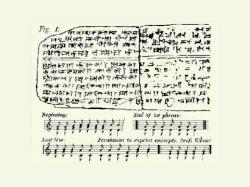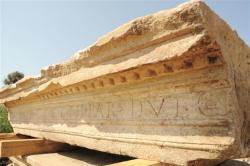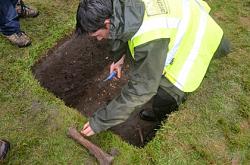INSTITUT SUPERIEUR D'ANTHROPOLOGIE
INSTITUTE OF ANTHROPOLOGY
ONLINE COURSES / COURS A DISTANCE
FALL TERM : OCTOBER 2014
REGISTER NOW
SYRIE –  Ugarit - In the early 1950s, archaeologists unearthed several clay tablets from the 14th century B.C.E.. Found, WFMU tells us, “in the ancient Syrian city of Ugarit,” these tablets “contained cuneiform signs in the hurrian language,” which turned out to be the oldest known piece of music ever discovered, a 3,400 year-old cult hymn. Anne Draffkorn Kilmer, professor of Assyriology at the University of California, produced the interpretation above in 1972. (She describes how she arrived at the musical notation—in some technical detail—in this interview.) Since her initial publications in the 60s on the ancient Sumerian tablets and the musical theory found within, other scholars of the ancient world have published their own versions. The piece, writes Richard Fink in a 1988 Archeologia Musicalis article, confirms a theory that “the 7-note diatonic scale as well as harmony existed 3,400 years ago.” This, Fink tells us, “flies in the face of most musicologist’s views that ancient harmony was virtually non-existent (or even impossible) and the scale only about as old as the Ancient Greeks.” Kilmer’s colleague Richard Crocker claims that the discovery “revolutionized the whole concept of the origin of western music.” So, academic debates aside, what does the oldest song in the world sound like? Listen to a midi version below and hear it for yourself. Doubtless, the midi keyboard was not the Sumerians instrument of choice, but it suffices to give us a sense of this strange composition, though the rhythm of the piece is only a guess.
Ugarit - In the early 1950s, archaeologists unearthed several clay tablets from the 14th century B.C.E.. Found, WFMU tells us, “in the ancient Syrian city of Ugarit,” these tablets “contained cuneiform signs in the hurrian language,” which turned out to be the oldest known piece of music ever discovered, a 3,400 year-old cult hymn. Anne Draffkorn Kilmer, professor of Assyriology at the University of California, produced the interpretation above in 1972. (She describes how she arrived at the musical notation—in some technical detail—in this interview.) Since her initial publications in the 60s on the ancient Sumerian tablets and the musical theory found within, other scholars of the ancient world have published their own versions. The piece, writes Richard Fink in a 1988 Archeologia Musicalis article, confirms a theory that “the 7-note diatonic scale as well as harmony existed 3,400 years ago.” This, Fink tells us, “flies in the face of most musicologist’s views that ancient harmony was virtually non-existent (or even impossible) and the scale only about as old as the Ancient Greeks.” Kilmer’s colleague Richard Crocker claims that the discovery “revolutionized the whole concept of the origin of western music.” So, academic debates aside, what does the oldest song in the world sound like? Listen to a midi version below and hear it for yourself. Doubtless, the midi keyboard was not the Sumerians instrument of choice, but it suffices to give us a sense of this strange composition, though the rhythm of the piece is only a guess.
Listen to the Oldest Song in the World: https://richarddawkins.net/2014/09/listen-to-the-oldest-song-in-the-world-a-sumerian-hymn-written-3400-years-ago/?
TURQUIE –  Parion- A 2,000-year-old inscription has been found in Parion, an ancient port city of the Hellenistic era located in the northwestern province of Çanakkale’s Biga district. Excavations at the site have recently been ongoing in seven different spots, along with restoration and conversation works, and a Byzantine chapel was also found in the area in previous years. The head of the excavation team, Associate Professor Vedat Keleş, said excavations at the ancient city would be finished soon, adding that they had discovered very important findings this year. “This year was the 10th year of the excavations and it was very productive for us. A technical team of 60 people from seven universities and 70 workers provided by our main sponsor have been working at the site. The latest findings are like a key document for us, including 2,000 year-old inscriptions that confirmed our previous information about the ancient site,” Keleş said. “We understand from the inscriptions that Parion was the most important colony city of the region, or maybe of Anatolia. They also give important clues about economic, military and architectural activities in the area, which are supported by theater excavations. The odeon, a building for musical events, that we unearthed could hold 200 people, making it one of the biggest in Anatolia,” he added.
Parion- A 2,000-year-old inscription has been found in Parion, an ancient port city of the Hellenistic era located in the northwestern province of Çanakkale’s Biga district. Excavations at the site have recently been ongoing in seven different spots, along with restoration and conversation works, and a Byzantine chapel was also found in the area in previous years. The head of the excavation team, Associate Professor Vedat Keleş, said excavations at the ancient city would be finished soon, adding that they had discovered very important findings this year. “This year was the 10th year of the excavations and it was very productive for us. A technical team of 60 people from seven universities and 70 workers provided by our main sponsor have been working at the site. The latest findings are like a key document for us, including 2,000 year-old inscriptions that confirmed our previous information about the ancient site,” Keleş said. “We understand from the inscriptions that Parion was the most important colony city of the region, or maybe of Anatolia. They also give important clues about economic, military and architectural activities in the area, which are supported by theater excavations. The odeon, a building for musical events, that we unearthed could hold 200 people, making it one of the biggest in Anatolia,” he added.
http://www.hurriyetdailynews.com/inscriptions-reveal-parions-importance-.aspx?pageID=238&nID=71213&NewsCatID=375
ROYAUME UNI –  Moncreiffe Hill- Painstaking excavations of one of Tayside’s greatest iron age seats of power have been carried out on Moncreiffe Hill. Chieftains once controlled the land for miles around from its summit, which was home to two giant hill forts. Thick stone walls, perhaps as much as 12 feet high and topped by a log palisade, crowned the hill from where its ruler had a commanding view of his surroundings. Despite its obvious importance, there has been almost no archaeological study of Moredun Top — nor of the smaller fort on a lower site on the hill. In fact, nothing but a small piece of jet has ever been removed from the site. That is now changing as David Strachan from Perth and Kinross Heritage Trust leads a team on the hill to begin a detailed new project. It is being delivered through the Tay Landscape Partnership with funding from the Heritage Lottery Fund, among others, and aims to uncover the secret past of the familiar landmarks, beginning with the smaller of the two forts. Excavations at Moredun Top will then follow, with three separate digs to be carried out each year for the next three years. Moncreiffe hill fort, where the work is beginning, is believed to date back to the late iron age and has views over the Earn valley. Hill forts feature regularly on the landscape of the Ochil and Sidlaw hills and a number have been excavated and studied.
Moncreiffe Hill- Painstaking excavations of one of Tayside’s greatest iron age seats of power have been carried out on Moncreiffe Hill. Chieftains once controlled the land for miles around from its summit, which was home to two giant hill forts. Thick stone walls, perhaps as much as 12 feet high and topped by a log palisade, crowned the hill from where its ruler had a commanding view of his surroundings. Despite its obvious importance, there has been almost no archaeological study of Moredun Top — nor of the smaller fort on a lower site on the hill. In fact, nothing but a small piece of jet has ever been removed from the site. That is now changing as David Strachan from Perth and Kinross Heritage Trust leads a team on the hill to begin a detailed new project. It is being delivered through the Tay Landscape Partnership with funding from the Heritage Lottery Fund, among others, and aims to uncover the secret past of the familiar landmarks, beginning with the smaller of the two forts. Excavations at Moredun Top will then follow, with three separate digs to be carried out each year for the next three years. Moncreiffe hill fort, where the work is beginning, is believed to date back to the late iron age and has views over the Earn valley. Hill forts feature regularly on the landscape of the Ochil and Sidlaw hills and a number have been excavated and studied.
http://www.thecourier.co.uk/news/local/perth-kinross/archaeologists-hoping-to-scrape-their-way-to-moncreiffe-hill-s-ancient-secrets-1.554790
ROYAUME UNI –  Caistor St Edmund - The village of Caistor St Edmund, near Norwich, is renowned for its Roman heritage and fortifications, having been founded as Venta Icenorum in around AD 60. A hotbed of archaeology which originally produced a forum, two temples, a bath complex, a south gate and a large dwelling following initial excavations in 1929, its latest detectives, from the Caistor Roman Project, have spent five years digging for various victories here. The project has previously discovered ditches relating to walls from 100 AD, and these pits could purge bones and metal objects
Caistor St Edmund - The village of Caistor St Edmund, near Norwich, is renowned for its Roman heritage and fortifications, having been founded as Venta Icenorum in around AD 60. A hotbed of archaeology which originally produced a forum, two temples, a bath complex, a south gate and a large dwelling following initial excavations in 1929, its latest detectives, from the Caistor Roman Project, have spent five years digging for various victories here. The project has previously discovered ditches relating to walls from 100 AD, and these pits could purge bones and metal objects
http://www.culture24.org.uk/history-and-heritage/archaeology/art497741-Archaeologists-reveal-Roman-Norfolk-with-in-demand-garden-digs-Caistor-Edmund